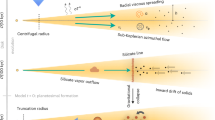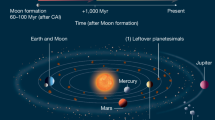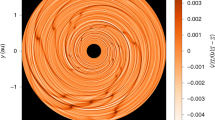Abstract
The origin of Mercury still remains poorly understood compared with the other rocky planets of the Solar System. To explain its internal structure, it is usually considered to be the product of a giant impact. However, most studies assume a binary collision between bodies of substantially different masses, which seems to be unlikely according to N-body simulations. Here, we perform smoothed-particle hydrodynamics simulations to investigate the conditions under which collisions of similar-mass bodies are able to form a Mercury-like planet. Our results show that such collisions can fulfil the necessary constraints in terms of mass (0.055 M⊕) and composition (30/70 silicate-to-iron mass ratio) within less than 5%, as long as the impact angles and velocities are properly adjusted according to well established scaling laws. With these results, we broaden the scope of plausible formation scenarios by presenting those that are more frequent in numerical simulations, less constrained in planetary contexts and thus more likely to happen.
This is a preview of subscription content, access via your institution
Access options
Access Nature and 54 other Nature Portfolio journals
Get Nature+, our best-value online-access subscription
$32.99 / 30 days
cancel any time
Subscribe to this journal
Receive 12 digital issues and online access to articles
$119.00 per year
only $9.92 per issue
Buy this article
- Purchase on SpringerLink
- Instant access to full article PDF
Prices may be subject to local taxes which are calculated during checkout





Similar content being viewed by others
Data availability
The datasets generated and/or analysed during the current study are available at https://doi.org/10.5281/zenodo.15145979 (ref. 65). Additional data are available upon request from the corresponding authors. Source data are provided with this paper.
Code availability
The SPH code miluphcuda is in active development and publicly available via GitHub at https://github.com/christophmschaefer/miluphcuda.
References
Peplowski, P. N. et al. Radioactive elements on Mercury’s surface from MESSENGER: implications for the planet’s formation and evolution. Science 333, 1850–1852 (2011).
Nittler, L. R. et al. The major-element composition of Mercury’s surface from MESSENGER X-ray spectrometry. Science 333, 1847–1850 (2011).
Evans, L. G. et al. Chlorine on the surface of Mercury: MESSENGER gamma-ray measurements and implications for the planet’s formation and evolution. Icarus 257, 417–427 (2015).
Benz, W., Slattery, W. L. & Cameron, A. G. W. Collisional stripping of Mercury’s mantle. Icarus 74, 516–528 (1988).
Agnor, C. & Asphaug, E. Accretion efficiency during planetary collisions. Astrophys. J. Lett. 613, L157–L160 (2004).
Benz, W., Anic, A., Horner, J. & Whitby, J. A. The origin of Mercury. Space Sci. Rev. 132, 189–202 (2007).
Asphaug, E. Impact origin of the Moon? Annu. Rev. Earth Planet. Sci. 42, 551–578 (2014).
Ebel, D. S. & Stewart, S. T. in Mercury. The View after MESSENGER Vol. 45 (eds Solomon, S. C. et al.) 497–515 (Cambridge Univ. Press, 2018).
Raymond, S. N., Izidoro, A. & Morbidelli, A. in Planetary Astrobiology (eds Meadows, V. S. et al.) 287–324 (Univ. Arizona Press, 2020).
Raymond, S. N., O’Brien, D. P., Morbidelli, A. & Kaib, N. A. Building the terrestrial planets: constrained accretion in the inner Solar System. Icarus 203, 644–662 (2009).
Izidoro, A., Raymond, S. N., Morbidelli, A. & Winter, O. C. Terrestrial planet formation constrained by Mars and the structure of the asteroid belt. Mon. Not. R. Astron. Soc. 453, 3619–3634 (2015).
Lykawka, P. S. & Ito, T. Terrestrial planet formation: constraining the formation of Mercury. Astrophys. J. 838, 106 (2017).
Izidoro, A. & Raymond, S. N. in Handbook of Exoplanets (eds Deeg, H. J. & Belmonte, J. A.) 2365–2423 (Springer, 2018).
Clement, M. S., Kaib, N. A. & Chambers, J. E. Dynamical constraints on Mercury’s collisional origin. Astron. J. 157, 208 (2019).
Franco, P., Izidoro, A., Winter, O. C., Torres, K. S. & Amarante, A. Explaining Mercury via a single giant impact is highly unlikely. Mon. Not. R. Astron. Soc. 515, 5576–5586 (2022).
Clement, M. S., Chambers, J. E., Kaib, N. A., Raymond, S. N. & Jackson, A. P. Mercury’s formation within the early instability scenario. Icarus 394, 115445 (2023).
Duncan, M. J., Levison, H. F. & Lee, M. H. A multiple time step symplectic algorithm for integrating close encounters. Astron. J. 116, 2067–2077 (1998).
Chambers, J. E. A hybrid symplectic integrator that permits close encounters between massive bodies. Mon. Not. R. Astron. Soc. 304, 793–799 (1999).
Chambers, J. E. Late-stage planetary accretion including hit-and-run collisions and fragmentation. Icarus 224, 43–56 (2013).
Emsenhuber, A. et al. Realistic on-the-fly outcomes of planetary collisions. II. Bringing machine learning to N-body simulations. Astrophys. J. 891, 6 (2020).
Burger, C., Bazsó, Á. & Schäfer, C. M. Realistic collisional water transport during terrestrial planet formation. Self-consistent modeling by an N-body–SPH hybrid code. Astron. Astrophys. 634, A76 (2020).
Cameron, A. G. W., Benz, W., Fegley, B. Jr & Slattery, W. L. in Mercury (eds Vilas, F. et al.) 692–708 (Univ. Arizona Press, 1988).
Asphaug, E. Similar-sized collisions and the diversity of planets. Geochemistry 70, 199–219 (2010).
Asphaug, E. & Reufer, A. Mercury and other iron-rich planetary bodies as relics of inefficient accretion. Nat. Geosci. 7, 564–568 (2014).
Sarid, G., Stewart, S. T. & Leinhardt, Z. M. in 45th Annual Lunar and Planetary Science Conference 2723 (LPI, 2014).
Chau, A., Reinhardt, C., Helled, R. & Stadel, J. Forming Mercury by giant impacts. Astrophys. J. 865, 35 (2018).
Gladman, B. & Coffey, J. Mercurian impact ejecta: meteorites and mantle. Meteorit. Planet. Sci. 44, 285–291 (2009).
O’Brien, D. P., Morbidelli, A. & Levison, H. F. Terrestrial planet formation with strong dynamical friction. Icarus 184, 39–58 (2006).
Jackson, A. P., Gabriel, T. S. J. & Asphaug, E. I. Constraints on the pre-impact orbits of Solar System giant impactors. Mon. Not. R. Astron. Soc. 474, 2924–2936 (2018).
Stewart, S. T. et al. Mercury impact origin hypothesis survives the volatile crisis: implications for terrestrial planet formation. In 47th Annual Lunar and Planetary Science Conference https://www.hou.usra.edu/meetings/lpsc2016/pdf/2954.pdf (LPI, 2016).
Clement, M. S., Kaib, N. A., Raymond, S. N., Chambers, J. E. & Walsh, K. J. The early instability scenario: terrestrial planet formation during the giant planet instability, and the effect of collisional fragmentation. Icarus 321, 778–790 (2019).
Ebel, D. S. & Alexander, C. M. O. Equilibrium condensation from chondritic porous IDP enriched vapor: implications for Mercury and enstatite chondrite origins. Planet. Space Sci. 59, 1888–1894 (2011).
Wurm, G., Trieloff, M. & Rauer, H. Photophoretic separation of metals and silicates: the formation of Mercury-like planets and metal depletion in chondrites. Astrophys. J. 769, 78 (2013).
Pignatale, F. C., Liffman, K., Maddison, S. T. & Brooks, G. 2D condensation model for the inner Solar Nebula: an enstatite-rich environment. Mon. Not. R. Astron. Soc. 457, 1359–1370 (2016).
Kruss, M. & Wurm, G. Seeding the formation of Mercurys: an iron-sensitive bouncing barrier in disk magnetic fields. Astrophys. J. 869, 45 (2018).
Kruss, M. & Wurm, G. Composition and size dependent sorting in preplanetary growth: seeding the formation of Mercury-like planets. Planet. Sci. J. 1, 23 (2020).
Stewart, S. T. & Leinhardt, Z. M. Collisions between gravity-dominated bodies. II. The diversity of impact outcomes during the end stage of planet formation. Astrophys. J. 751, 32 (2012).
Clement, M. S., Chambers, J. E. & Jackson, A. P. Dynamical avenues for Mercury’s origin. I. The lone survivor of a primordial generation of short-period protoplanets. Astron. J. 161, 240 (2021).
Gabriel, T. S. J. et al. Gravity-dominated collisions: a model for the largest remnant masses with treatment for “hit and run” and density stratification. Astrophys. J. 892, 40 (2020).
Leinhardt, Z. M. & Stewart, S. T. Collisions between gravity-dominated bodies. I. Outcome regimes and scaling laws. Astrophys. J. 745, 79 (2012).
Svetsov, V. Cratering erosion of planetary embryos. Icarus 214, 316–326 (2011).
Cambioni, S. et al. The effect of inefficient accretion on planetary differentiation. Planet. Sci. J. 2, 93 (2021).
Hubbard, A. Explaining Mercury’s density through magnetic erosion. Icarus 241, 329–335 (2014).
Morbidelli, A., Lunine, J. I., O’Brien, D. P., Raymond, S. N. & Walsh, K. J. Building terrestrial planets. Annu. Rev. Earth Planet. Sci. 40, 251–275 (2012).
Lawrence, D. J. et al. Evidence for water ice near Mercury’s north pole from MESSENGER neutron spectrometer measurements. Science 339, 292 (2013).
Brasser, R., Mojzsis, S. J., Werner, S. C., Matsumura, S. & Ida, S. Late veneer and late accretion to the terrestrial planets. Earth Planet. Sci. Lett. 455, 85–93 (2016).
Hyodo, R., Genda, H. & Brasser, R. Modification of the composition and density of Mercury from late accretion. Icarus 354, 114064 (2021).
Frantseva, K. et al. Exogenous delivery of water to Mercury. Icarus 383, 114980 (2022).
Schäfer, C. et al. A smooth particle hydrodynamics code to model collisions between solid, self-gravitating objects. Astron. Astrophys. 590, A19 (2016).
Schäfer, C. M. et al. A versatile smoothed particle hydrodynamics code for graphic cards. Astron. Comput. 33, 100410 (2020).
Thompson, S. L. ANEOS: Analytic Equations of State for Shock Physics Codes Input Manual Technical Report SAND-89-2951 (Sandia National Labs, 1990).
Melosh, H. J. A hydrocode equation of state for SiO2. Meteorit. Planet. Sci. 42, 2079–2098 (2007).
Grady, D. & Kipp, M. Continuum modelling of explosive fracture in oil shale. Int. J. Rock Mech. Min. Sci. Geomech. Abstr. 17, 147–157 (1980).
Benz, W. & Asphaug, E. Simulations of brittle solids using smooth particle hydrodynamics. Comput. Phys. Commun. 87, 253–265 (1995).
Melosh, H. J. Impact Cratering: A Geologic Process (Oxford Univ. Press, 1989).
Jutzi, M. SPH calculations of asteroid disruptions: the role of pressure dependent failure models. Planet. Space Sci. 107, 3–9 (2015).
Burger, C. & Schäfer, C. M. Applicability and limits of simple hydrodynamic scaling for collisions of water-rich bodies in different mass regimes. In Proc. First Greek–Austrian Workshop on Extrasolar Planetary Systems (eds Maindl, T. I. et al.) 63–81 (2017).
Emsenhuber, A., Jutzi, M. & Benz, W. SPH calculations of Mars-scale collisions: the role of the equation of state, material rheologies, and numerical effects. Icarus 301, 247–257 (2018).
Diehl, S., Rockefeller, G., Fryer, C. L., Riethmiller, D. & Statler, T. S. Generating optimal initial conditions for smoothed particle hydrodynamics simulations. Publ. Astron. Soc. Aust. 32, e048 (2015).
Burger, C., Maindl, T. I. & Schäfer, C. M. Transfer, loss and physical processing of water in hit-and-run collisions of planetary embryos. Cel. Mech. Dyn. Astron. 130, 2 (2018).
Quintana, E. V., Barclay, T., Borucki, W. J., Rowe, J. F. & Chambers, J. E. The frequency of giant impacts on Earth-like worlds. Astrophys. J. 821, 126 (2016).
Stadel, J. G. Cosmological N-Body Simulations and Their Analysis. PhD thesis, Univ. Washington (2001).
Benincasa, S. M., Wadsley, J. W., Couchman, H. M. P., Pettitt, A. R. & Tasker, E. J. A tale of two clump masses: a new way to study clump formation in simulations. Mon. Not. R. Astron. Soc. 486, 5022–5036 (2019).
Timpe, M. L., Han Veiga, M., Knabenhans, M., Stadel, J. & Marelli, S. Machine learning applied to simulations of collisions between rotating, differentiated planets. Comput. Astrophys. Cosmol. 7, 2 (2020).
Franco, P. et al. SPH Simulation data of article Forming Mercury by a grazing giant collision involving similar mass bodies. Zenodo https://doi.org/10.5281/zenodo.15145979 (2025).
Acknowledgements
P.F., F.R. and O.C.W. acknowledge support from the Brazilian National Council of Research—CNPq (grants 305210/2018-1 and 312429/2023-1). R.S., C.B. and C.M.S. appreciate support from the German Research Foundation—DFG (projects 285676328 and 446102036). Simulations have been performed using the cluster of the Grupo de Dinâmica Orbital e Planetologia of UNESP, financed by the São Paulo State Research Foundation—FAPESP (grant 2016/24561-0). We also thank the Brazilian Federal Agency for Support and Evaluation of Graduate Education—CAPES, in the scope of the programme CAPES-PrInt, process 88887.310463/2018-00, International Cooperation Project number 3266.
Author information
Authors and Affiliations
Contributions
P.F. set up, performed and analysed the simulations, interpreted the results and wrote the manuscript. F.R. and O.C.W. proposed the study, advised on its execution and revised the results and the manuscript. R.S., C.B. and C.M.S. contributed with the configuration, modification and application of the SPH code. All the authors contributed to the discussion of the results.
Corresponding authors
Ethics declarations
Competing interests
The authors declare no competing interests.
Peer review
Peer review information
Nature Astronomy thanks Matt Clement, Ryuki Hyodo, Nathan Kaib and the other, anonymous, reviewer(s) for their contribution to the peer review of this work.
Additional information
Publisher’s note Springer Nature remains neutral with regard to jurisdictional claims in published maps and institutional affiliations.
Extended data
Extended Data Fig. 1 Scheme of a generic collision between two planet-sized bodies.
Schematic of a collision configuration. \(\overrightarrow{{V}_{i}}\) denotes the relative impact velocity between the target of radius Rt and the projectile of radius Rp. The impact angle, θ, is defined as the angle between the lines Rt + Rp and the relative velocity vector at the moment of first contact. Lint represents the interacting length, defined as the projected length of the projectile that overlaps the target.
Supplementary information
Supplementary Video 1
SPH simulation of the collision of a proto-Mercury, of 0.13 M⊕, with a target of 0.2 M⊕. The proto-Mercury is represented by a pink mantle and a turquoise core. The target is represented by a red mantle and a yellow core. The impact angle is 32.5°, and the impact velocity is 22.3 km s−1. The total time span of the simulation is 48 h. The resulting Mercury-like body has a ZFe of 0.68 and a mass of 0.056 M⊕, very close to the current values.
Source data
Source Data Fig. 1
Statistical source data.
Source Data Fig. 2
Statistical source data.
Source Data Fig. 3
Statistical source data.
Source Data Fig. 4
Statistical source data.
Source Data Fig. 5
Statistical source data.
Rights and permissions
Springer Nature or its licensor (e.g. a society or other partner) holds exclusive rights to this article under a publishing agreement with the author(s) or other rightsholder(s); author self-archiving of the accepted manuscript version of this article is solely governed by the terms of such publishing agreement and applicable law.
About this article
Cite this article
Franco, P., Roig, F., Winter, O.C. et al. Formation of Mercury by a grazing giant collision involving similar-mass bodies. Nat Astron 9, 1158–1166 (2025). https://doi.org/10.1038/s41550-025-02582-y
Received:
Accepted:
Published:
Issue date:
DOI: https://doi.org/10.1038/s41550-025-02582-y



